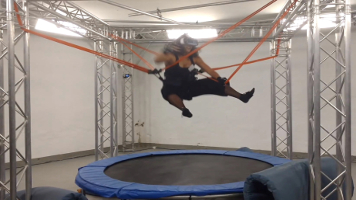
Using a trampoline as a natural 3D user interface with a head-mounted display for virtual reality entertainment is a novel and challenging task. High latencies between interaction and feedback or inaccurate tracking of the user’s movement can lead to cybersickness. In the scope of this project we identified the most appropriate solutions for the described challenge by testing multiple tracking and virtual reality technologies. A fast and precise network-based system was developed using OptiTrack as a tracking solution and Samsung GearVR as a Head-Mounted Display.
The first prototype was an endless-runner Jump ’N’ Run game, placing the user in a lava scenery. By jumping with a clear offset from the origin to the left or right side, the user switches between three lanes. With power-ups placed in the scene, the user gains a temporary speed or jump height boost. The speed can also be raised by performing running gestures while jumping. Bouncing in a seating position resets the speed. Other gaming elements like collectable coins and flaming obstacles extends the experience. Besides switching lanes to avoid obstacles, the user can also shoot water out of his wrists to extinguish the fire obstacles.
The second prototype immerses the user in a space scenario. In this VR experience, we added elastic ropes as a necessity for security reasons. With this setup, the user should get into a belt with elastic ropes mounted on a traverse wrapping the trampoline. Then, after an initial calibration that matches a virtual avatar to the user´s body, the user plays a walk-though tutorial on how to interact in the game. The user’s task in this experience is to prevent different space ships from attacking him. This is accomplished by jumping or ducking and thus avoiding the obstacles. Simple gestures like clapping hands and stretching the arm towards objects allow for some interactions in the scene and provide audio-visual feedback (digital effects, sound, etc).
In the last prototype was editted by two student groups. As a tall virtual troll the user is standing on a platform sorrounded by tiny villages. Here, the task is to destroy villages through jumping on them. In this way the user receives points but his highscore is threatenet by little stone throwing catapults. To defend his highscore the user has to avoid the stones or block them with his hands. Besides that, when the jumping strength of a village destruction approach is to weak then it will fail. So the user has to do sports in order to receive points. With the gamification aspect of this prototype one can imagine to use such an applicaton for sports workout. In contrast to the two other projects, the IK-Steering was improved. Furthermore the user has the possibility to interact with real world objects while jumping. This is possible through the flexible marker technology of OptiTrack.
Trampoline 2016
Iteration 1 (2016): Roman Wiche, Okan Köse, Daniel Kirchhof, Marcel Tiator
Iteration 2 (2016): Fritz Dorn
Iteration 3 (2017): Florian Kaulfersch, Stefan Böhling, Ben Fischer, Hendrik Schulte, Nannette Ratz, Paul Kretschel, Jana Pelzer, Fabian Marx, Simon Jacobs, Christoph Butschkau
Past exhibition:
Innovationstag 2016 (Web: www.innovationshub.de, Video: on Vimeo)
Conference-Paper Intetain 2017 (Web: www.intetain.org)
Innovationstag 2017 (Web: www.innovationshub.de, Video: on Vimeo)
Digility 2017 (Web: www.digility.de)
Next Level 2017 (Web: www.next-level.org)